
the reinvention issue issue no. 51
What is the purpose of a garbage bag? For Marija Jovic, trash bags have been the transporters of clothes with history and memories woven into the seams.

Clothes and I
That’s gay. And that’s the point. Austin Kim discusses queer reinvention as reflected through his style and that of other Northwestern students.



Hand-Me-Downs
Embracing inheritance through family photos that show where we may come from and where we’ve landed in our modern day.
Metamorphosis
Transforming yourself can be a freeing process, shedding your old skin after hibernation and coming into a vibrant existence—like the reshaping of a caterpillar to a butterfly.

Beyond the Glow Up
Inspired by a quote from a transgender author, Gigi Cepeda discusses the beauty of reinvention necessitated by transgender identity.

After shaving her head, Haben Fessahazion was forced to confront who she really is — without hiding behind her hair.

06 Garbage Bags 08 12 24 36 38
New Hair, New Me?
EDITOR-IN-CHIEF
Jude Cramer
PRINT CREATIVE DIRECTOR
Sara Gronich
PRINT MANAGING EDITOR
Vaibhavi Hemasundar
PRINT DESIGN EDITOR
Quynh-Nhi Tran
DIGITAL DESIGN EDITOR
Isabelle Hauf
MEMBERSHIP DIRECTOR
Sara Frank
DIGITAL MANAGING EDITOR
Molly Van Gorp
COPY EDITOR
Gabi Kurzer
SOCIAL MEDIA EDITOR
Emi Silverstein
CORPORATE DIRECTOR
Aditi Ghei
STYLING DIRECTOR
Lisa Vicini
FINANCE DIRECTOR
Sam Albright
EDITOR-IN-CHIEF
Amina Elmasry
DIGITAL CREATIVE DIRECTOR
Yola Mzizi
PRINT MANAGING EDITOR
Erica Davis
DIGITAL DESIGN EDITOR
Ruth Ellen Berry
WEBSITE DESIGNER
Meher Yeda
DIGITAL MANAGING EDITOR
Rebecca Aizin
DIGITAL MANAGING EDITOR
Carly Witteman
MULTIMEDIA EDITOR
Libby Markham
MULTIMEDIA EDITOR
Tara King
CORPORATE DIRECTOR
Grace Shi
STYLING DIRECTOR
Laila Simone Robinson
PHOTOGRAPHY EDITOR
Wyatt Morris
CORPORATE TEAM
Abu Hoque, Allison Gould, Annie Ho, Annika Srivastava, Benjamin Weiss, Catalina Castro, Claire Wu, Hamnah Malik, Iliana Garner, Laila-Aicha Adouim, Lila Weiner, Mia Rhee, Nicole Feldman, Raya Bryant-Young, Rebecca Chen, Samantha Ortiz + Tanya Parasher
DESIGN TEAM
Margeaux Rocco, Allie Wicks, Michelle Sheen, Sabrina Eicher, Wendy Zhu + Zara Hasnani
EDITORIAL TEAM
Abigail Abdi, Alani Cox-Caceres, Alea Wilkins, Anna Souter, Audrey Clarendon, Augustus Glick, Austin Kim, Catherine Duncan, Claire O'Shaughnessy, Divya Bhardwaj, Ella Kuffour, Erin Corridon, Eve Leupold, Fatima Jalloh, Haben
Fessehaizon, Halliday Mafrige, Isabella Grau, Julia Mkrtychian, Kalycia Hodge, Kira Gopinath, Lauren Cohn, Lucia Shorr, Marija Jovic, Maya Krainc, Nyla Gilstrap, Rahib Yaher + Tamara Ulalisa
MULTIMEDIA TEAM
Anoushka Dasgupta, Aria Wozniak, Chiara Dorsi, Cooper Silverman, Elena Scott, Emma Brown, Kineyshi Fils-Esperant, Kim Jao, Lianna Amoruso, Madison Morgan, Mo O’Grady, Sama Ben Amer, Ysa Quiballo + Zai Dawodu
PHOTOGRAPHY TEAM
Grace Deng, Madison Smith, Hannah Carroll, Julia Nichols, Chirag Bachani, Marli Katz + Christina Yao
SOCIAL MEDIA TEAM
Angela Zheng, Isabella Moran, Kate Perez, Kayla Eichmann, Lucia Koo, McKenna Frey, Paola Hernandez, Rhea Dhar + Sarah Lonser
STYLING TEAM
Ilise Angel, Allison Arguezo, Anthony Barba-Perez, Eloise Brotzman, Kenny Davis, Elias Fan, Olivia Heimann, Tosin Okoh, Mark Park, Shelly Rood + Maira Walker Winter
03
2023
ZARA HASNANI DALLAS, TX JUNIOR DESIGN
"Reinvention means embracing changes, taking risks, and breaking away from old habits and ways of thinking. To me, it is less about physical changes to my appearance, but instead focuses on personal growth and new experiences."



JULIA NICHOLS JACKSONVILLE, FL
"Reinvention means evolving and beginning anew. It is the art of breaking the mold and finding freedom in embracing the truest form of what can be rather than simply accepting what is."
MARIJA JOVIC
"Reinvention means taking something meaningful and keeping the parts of it that still serve us, and letting go of those that don't. It's progress with an emphasis on the importance of the past."
"Reinvention means to me, either a small or total shift in vibe or energy. Especially when I change my hair or feel inspired to try out different fashion styles, it’s about doing something unfamiliar and fully accepting that."

contributors
SOPHOMORE PHOTO
LOS ANGELES, CA FRESHMAN EDITORIAL
JUNIOR STYLING
ILISE ANGEL SAN FRANCISCO, CA
FROM THE EDITORS thoughts


If there’s one constant in life, it’s change. As we grow, we evolve and respond to the environment around us. We change occupations, we try new foods, and our closets cycle through trend after trend. In STITCH’s Reinvention Issue, we’re taking a critical eye to what it means to rebrand and repurpose, what motivates us to change ourselves for better and for worse, and what our own styles might look like in a vacuum.
Our photoshoots tackle different kinds of reinvention: familial, personal, and natural. Our recreations of old family photos show how we both celebrate and diverge from our heritages. The classic makeover sequence gets turned on its head, bringing models from polished perfection to countercultural celebrations of identity. And a reinterpretation of the metamorphosis from caterpillar to butterfly revels in the freedom and beauty of finding a new side of yourself.
This exploration continues in our editorial pieces. Through personal essays on the role of hand-me-downs, hair transformations, and expressing queerness through clothing; pop culture deep dives on controversial pop stars, the intersection of technology and fashion, and representations of transness in TV and film; and creative pieces including poetry and an interactive quiz, our writers break down the concept of reinvention from every angle.
On a more sentimental note, we want to say thank you for reading STITCH. As we look back at our time as editors in chief, we’re so proud of the work this magazine has accomplished and the legacy we leave behind. We couldn’t be leaving it in more capable hands, and we can’t wait to see how STITCH will grow from here.
jude cramer & amina elmasry

05 Winter 2023
Garbage Bags: THE CYCLICAL NATURE OF FASHION
 By Marija Jovic
By Marija Jovic
Garbage bags are very direct in their purpose. A mode of transportation for trash, they serve as smoke screens that whisk away the waste we don’t wish to deal with anymore. This definition holds up only partially in my experience. Trash bags remove hindrances, but as a child I received them with the joy of presents on Christmas morning. Under all-consuming poverty, one man’s trash is a 9-year-old’s treasure.
Every couple of months, my mom’s church friend, Zora, would pull into our driveway in her scuffed 2008 Audi with its overflowing trunk. By the time she popped it open, I’d be by her side and ready to carry the trash bags inside, my rusty front door swinging shut behind me.
Once my mom and I completed our two back-and-forth trips, my mom would carefully untie the hefty bags, and my little treasures would come tumbling out: medium-waist bootcut jeans, blue Juicy Couture sweatsuits and oversized “I Heart San Fran” jackets. In her job as a house cleaner, Zora took out the trash in Calabasas, and I still wear those throwaways with a scavenger’s sense of pride.
Designed by Sabrina Eicher
When you’re younger, it's much easier to understand that clothing cycles through you, and not the other way around.Every owner breathes life and character into fabric, and that added personality doesn’t wash out. Every skirt I pulled out of a black trash bag had something to say. Every pair of leggings had a point to prove.
My favorite articles of clothing were always the ones that I knew would outlive me. They had seen the ‘70s, ‘80s and ‘90s, followed my grandmother from Bosnia to Serbia, to Germany, Greece and Egypt. My grandmother’s camel-colored coats are lined with satin and the stories of cities after midnight. When she tossed me items from her massive closet, I embodied her, donning her clothing and her courage. When these treasured pieces traveled home with me to Los Angeles, I wanted nothing more than to further their story. I imagined how they could grow with me, what stories they could whisper to my cousins and friends after I had nothing more to tell.
The oldest piece I own is a black velvet coat, which often feels like a second skin. It molded onto me when my grandmother first whispered stories intended only for my ears, a parting gift for her first grandchild

06 Winter 2023
FASHION
heading permanently towards America. It retells me those stories whenever I forget. I weave through Northwestern carrying the knowledge it holds: which cut of fish is best (meat closest to the tail) and how to pack your whole life into a small suitcase So many unspoken secrets are woven into the shawls my grandmother has gifted me.
It’s not just the antique, expensive items that get to live on. Almost every piece I’ve ever owned has a unique ability to transcend the realm of clothing and gain utility in other ways.



For this reason, I don’t think I’ve ever bought a rag.
I’ve used my dad’s old T-shirts, huge white masses with mismatching holes, to wipe up juice spills and dishwasher leaks. I’ve laid them down as padding while painting, and they turned purple and green from the runoff of color.
I went through stockings quicker than socks when I was little. They had jarring runs from toe to thigh within weeks, and they were too ruined for Sunday service. But every spring, my mom dug into my closet and pulled out the messy pile. She then sent my brothers and I out into the backyard to scavenge small leaves and blades of grass. She pressed the greens tightly onto an egg and wrapped it like a present within the stocking. I sometimes helped, holding the stocking as she tied the egg with a little
string. Thisishowyourgreat-grandmother madeEastereggs. Nothing was ever without another purpose.
As an 8-year-old ballerina, I acquired my favorite dress. It was made of glittery white tulle with a sparkly crown to match.
My second favorite dress was a floor-length purple gown covered in flowers, which I wore almost religiously when I was 12. Both dresses are oceans away now, hanging in the closets of my little godsisters. Despite the distance, I know they’re cared for, just as I’ve loved every piece that has passed through me.
" "
Every owner breathes life and character into fabric, and that added personality doesn’t wash out.
07 Winter 2023
CLOTHES AND I
 By Austin Kim
By Austin Kim





style and the journey to personal acceptance


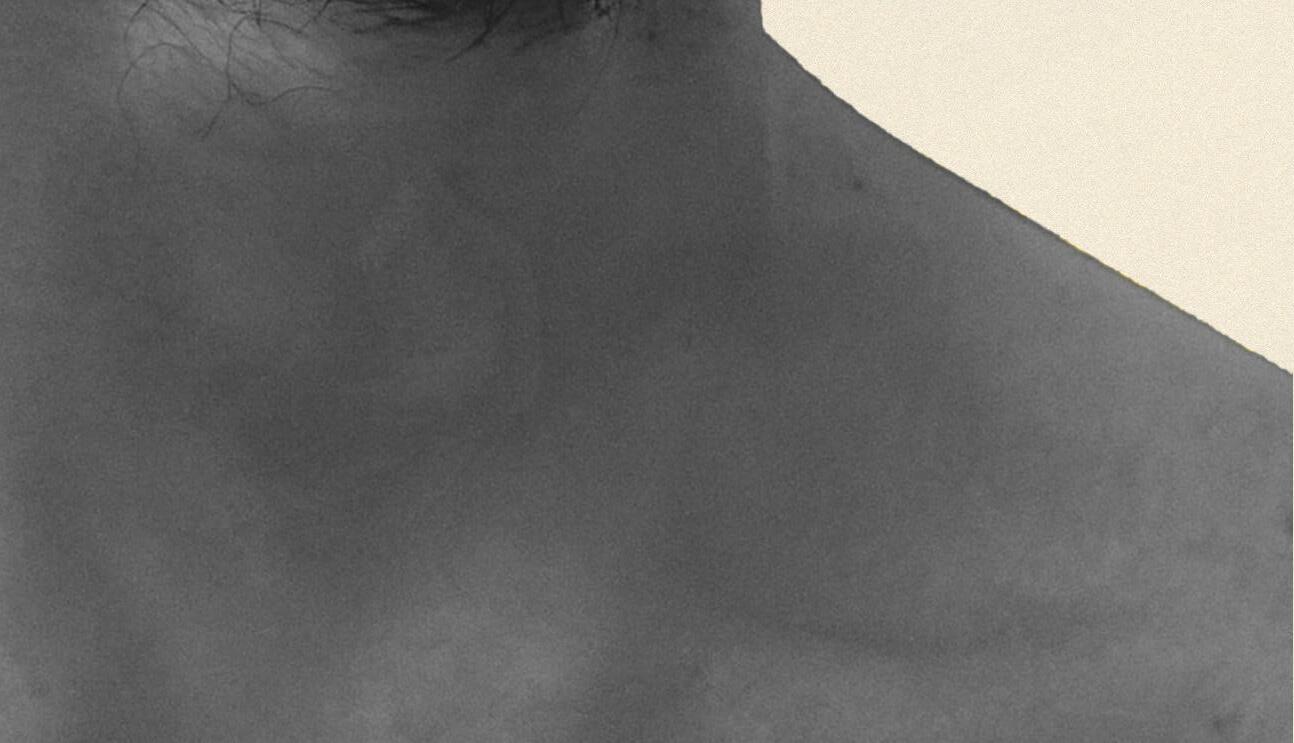


 Designed by Wendy Zhu
Designed by Wendy Zhu
08 Winter 2023
Image via Unsplash
Idressed weirdly in high school. I first got interested in clothing at the end of seventh grade, and my interest grew exponentially from there. By freshman year of high school, my daily uniform became a Telfar ringer T-shirt and a pair of oversized Eckhaus Latta blue jeans. I spent my spare time researching fashion brands, and my second home was the Opening Ceremony store on Los Angeles’ La Cienega Boulevard.
Although I could not verbalize it then, my interest in fashion was a form of protest. I had known I was gay since I was 7 years old and Googled “boys kissing” on my home computer. I never experienced ambiguity about my sexual identity. I was gay, and I knew it.



My middle school peers would repeatedly interrogate me, asking if I was gay. Of course, I denied, denied and denied their questions, while wearing vintage flared jeans and flashy, bright clothes that I definitely was not pulling off, in retrospect. In my closeted rage, I did not completely sacrifice who I was. Instead, I tried to express my identity in any way other than verbally.
Weinberg second-year Alex Sudmann said his style allowed him to control his narrative. “In high school, everyone always said, ‘You're gay,’ and I was like, ‘That's not true.’ Subconsciously, I tried to dress to reflect that narrative. I wanted to wear clothes that did not reflect any ambiguity in my [sexuality],” Sudmann says.
Sudmann came out during his senior year of high school and finally felt free to wear what he wanted. “I'll just put on this cropped t-shirt, wear whatever else and go to school. People can think what they want of me, and I'll just
keep going,” he says.
I came out at the end of my sophomore year, when the pandemic lockdown started. In the following weeks, I bleached my whole head then got a buzz cut. My already weird fashion sense turned into the most ridiculous, deep-cut choices possible.
First-year Dune Zawadzki had a different experience, embracing her queerness at an early age. “I've always known I was queer. I came out when I was like 12. I would hook up with girls at bar mitzvahs,” Zawadzki says.
Rather, Zawadzki underwent a journey of accepting her body and femininity.
“My style is like flamboyant androgyny. I've always been into male-ish aesthetics, but it was almost forced because I didn't feel comfortable feeling beautiful and feminine,” she says. “Now, I’m completely comfortable with tighter, form-fitting clothing because I'm not ashamed of my form anymore.”
The process of accepting and expressing one’s identity can be difficult for many people. However, Sudmann saw his coming out as a rare second chance at defining himself.
“I don't think a lot of people get the opportunity to be one person for so long, but then all of a sudden be like, ‘No, that's not me.’ I think one of the biggest ways to redefine how I saw myself was how I dressed,” Sudmann says.
My conversation with Sudmann led me to reconsider my outlook on my coming out experience. For a long time, I had been ashamed of how long it took me to come out. I regretted not being more confident in high school and not championing my gayness. But, the duality inherent to queer people is a
09 Winter 2023
I have felt authentically myself for the first time in my life."
beautiful, meaningful experience. I have come to treasure who I was when I was closeted and who I have become.
At Northwestern, I have felt authentically myself for the first time in my life. I have not felt pressured to lie and section off parts of my identity. I am grateful for the community I have found who accepts me.
Sudmann cited a similar feeling of acceptance. He’s from Malibu, California, and transferred to Northwestern from the University of Virginia because the UVA campus felt much less accepting than what he was used to. He feels much more at home at Northwestern.
“I'm feeling great about who I am. I don't think I've ever been more confident in my identity as I am here,” he says. “I'm surrounded by so many people who support me — it doesn't feel like [my identity] is different here. I don’t feel like I’m standing out.”
Zawadzki shares that sentiment: “It's also freeing because you can really be



androgynous. You can be feminine, you can be masculine, and there are always people who hype you up.”
I am grateful for the spaces I’ve found and the people I’ve met. The middle school version of me would not fathom a world where I talk openly about my desperate need for a boyfriend and the celebrity crush I have on Paul Mescal. The conversations that straight, cisgender people have without a second thought are things that have taken me years to get the confidence to say.
I am happy with where I am, though I still have work to do. For so long I felt I had to prove my masculinity because of my queerness. Whether through my style or through my behaviors, I felt I had to overcompensate to be a man. Now I have a better understanding of my own masculinity and am ready to embrace styles that reflect it. I want my gayness to be seen by my community and the world, a feeling that Zawadzki echoed.

" 10 Winter 2023
“People can always tell I'm queer. I'm glad that people catch on. It's nice to be able to be seen by your community and to see others in your community,” she says.
I am excited to see where my personal style goes from here. I want to lean into the absurd and wacky, but more importantly, I want to express who I am at my core. Throughout my life, clothes have protected and empowered me. The clothes I have worn tell the story of my
life better than I ever could.
As an adolescent, I was too scared to wear what I wanted. I feared judgment and did not want to stand out. Now, I embrace how powerful I feel in clothing. I wear my long wool coat when I want to feel assertive, or I opt for my slouchy blue jeans to recall my LA roots. I choose clothes that make me feel confident.




On fashion, Sudmann says, “That's my little way of standing up for who I am.”









11 Winter 2023
Images via Unsplash
hand -medowns






















Embracing inheritance through family photos that show where we come from and where we’ve landed in our modern day.
Photoshoot Directors: Sara Gronich, Yola Mzizi
Photographer: Wyatt Morris
Model Relations: Laila Simone Robinson
Stylists: Eloise Brotzman, Elias Xiwei Fan
Models: Olivia Abeyta, Zoe Davis
Credit to our models for their family photos
Fall 2022
12 Winter 2023



















14 Winter 2023









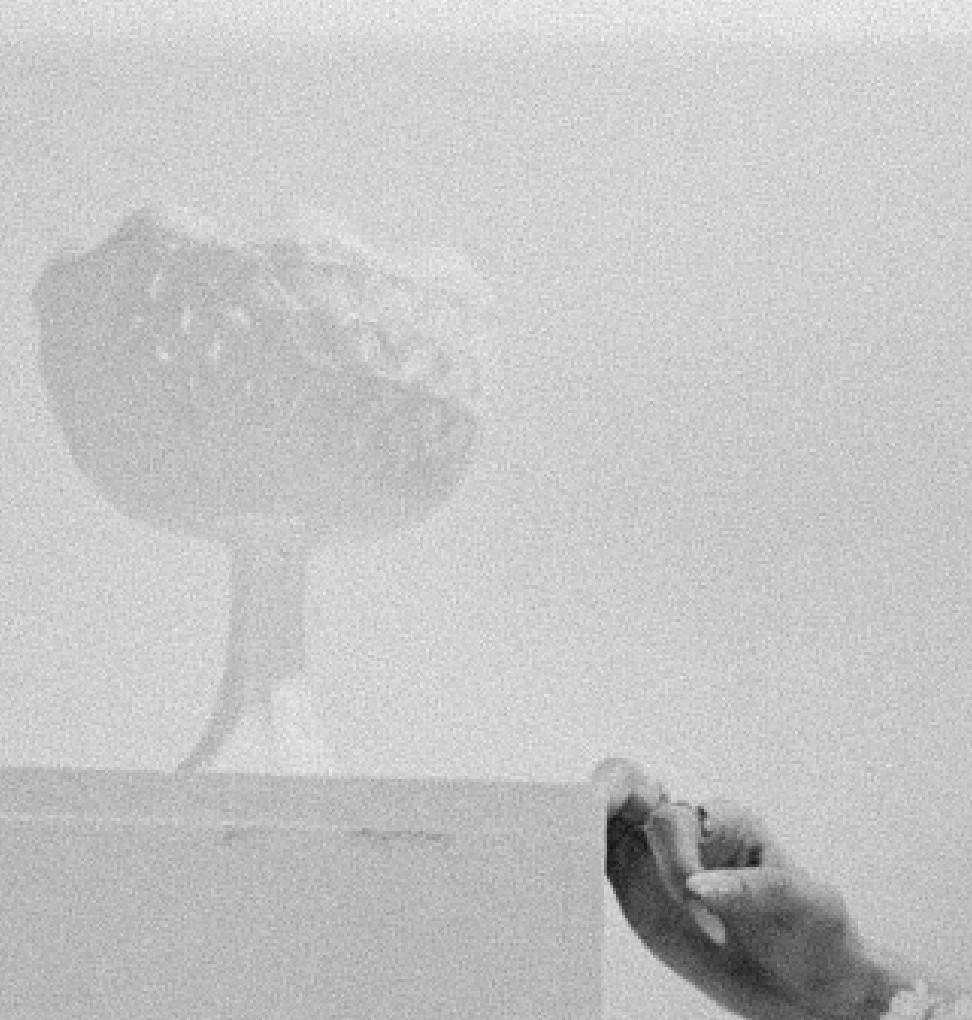















15 Winter 2023

16 Winter 2023


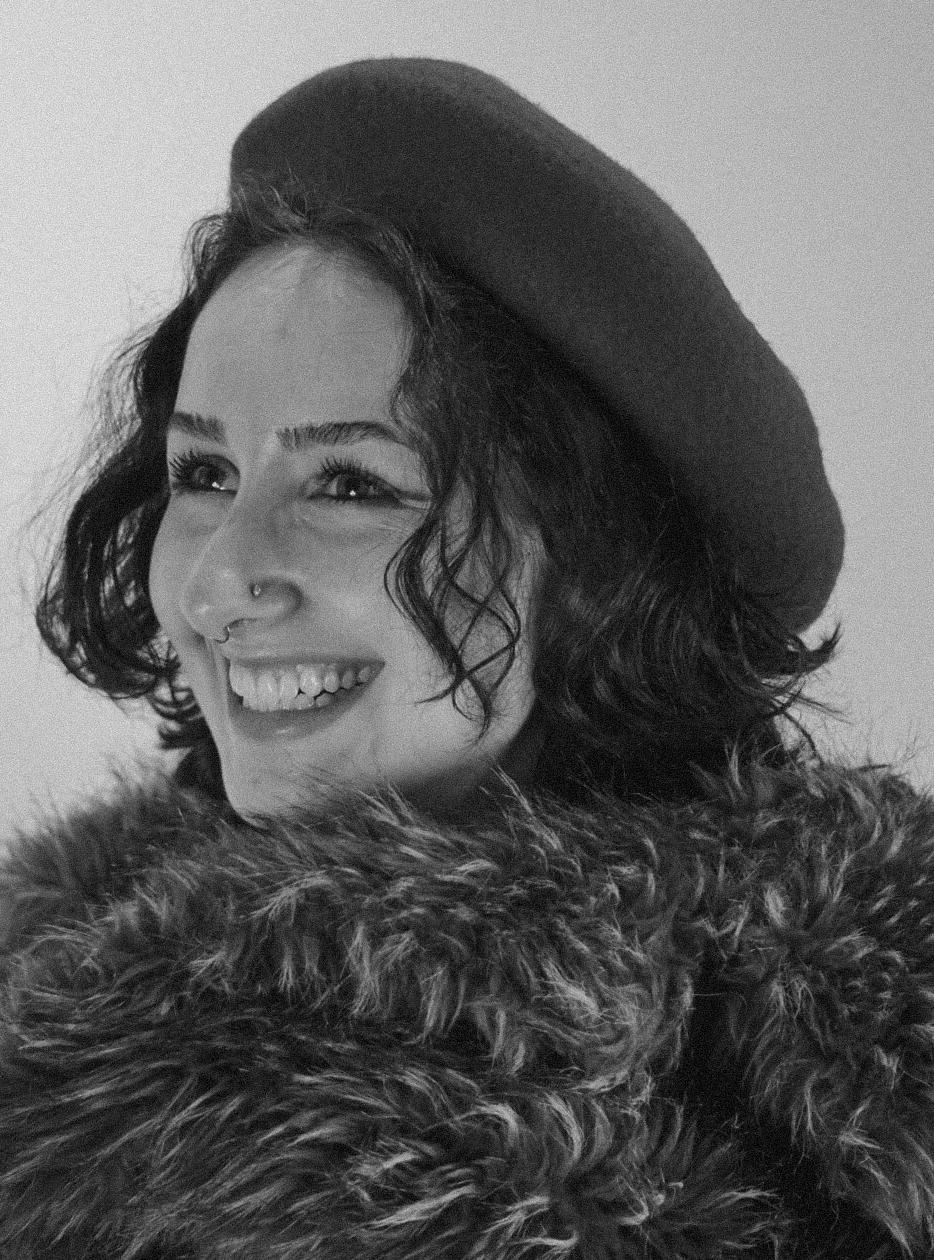
17 Winter 2023










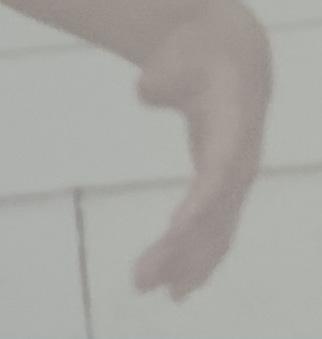



















18 Winter 2023











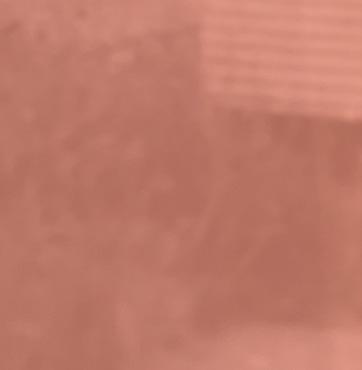


















19 Winter 2023





20 Winter 2023

21 Winter 2023
Rosalía: The Art and Atrocity of Reinvention
By Audrey Clarendon Designed By Margeaux Rocco
How do artists transform themselves and their work to enhance their craft? When does reinvention reignite our interest, and when does it go too far? Why was the internet so enraged and enthralled to see Rosalía, former contemporary flamenco stronghold, become Rosalía, bubble-gum-smacking art pop connoisseur?
The Art


Spanish superstar Rosalía knows how to obliterate convention. Her breakthrough sophomore album, “El Mal Querer,” masterfully fused traditional Spanish flamenco with contemporary pop and a narrative through line. This record was widely acclaimed and launched the Catalonia native into stardom. Since then, Rosalía has fine-tuned her ability to riff, rework and reinvent, releasing her most “sonically ambitious” project yet, “Motomami,” in March 2022. The experimental genre-bending nature of Rosalía and “Motomami” has captivated and bewildered audiences, reminding some of Björk in her heyday or
of a certain former Kardashian spouse who shall not be named. Listening to the record in full may bring on a sort of “sonic whiplash” with its back-to-back usage of traditional bolero, forgotten Soulja Boy hit samples, TikTok sounds, reggaetón, hyperpop and jazzy piano riffs. In her piecemeal approach to art and music, the potential for source material is endless. There are no limits for what can be sampled, covered or remixed. Everything is on the table for reworking and reinvention, and it's Rosalía’s job to patch it all together.
The transformative spirit of not only her music but also her artistic identity is on plain view in “Saoko,” the opening track of “Motomami.” She raps:
“Eh, yo soy muy mía, yo me transformo Una mariposa, yo me transformo”
“I’m very much me, I transform A butterfly, I transform”
It’s not hard to hear themes of freedom and renewal in the record with its breadth of source inspiration and variability. Tempo and genre are merely her playground, and “Motomami” her plea for artistic liberation.
Rosalía’s music is a constellation of her wellroundedness and an amalgamation of her many worlds, but she argues that this is simply an elevated form of tactics humans utilize naturally. She claims that as long as you employ respect and love in transforming others’ work, it always makes sense.


Rosalía’s globetrotting discography and style have not only brought her accolades. In her pursuit

22 Winter 2023
The Atrocity






of transformation it seems she’s stepped on the toes of some established and marginalized identities. Flamenco, Rosalía’s musical foundation, originates from the Gitanos, or the Spanish Romani. Many Gitanos oppose her rise to “Flamenco Poster Girl” status and her riffing on a culture that never belonged to her. As a white Spaniard, flamenco was not her tradition to adopt and reinvent. Additionally, Rosalía boasts oodles of Latin Grammys, indulges in Afro-Caribbean beats and slang, holds a comfortable spot in the Urban genre and
proclaims she feels Latina despite being fully Spanishblooded.
To be human is to communicate and exchange, but never to the point where you overshadow the creators of a craft or misrepresent your own origins. Despite what Rosalía may like to believe, her ventures into the world of Latin music and Romani culture are a trend. Her amalgamating of sounds and genres is a feat to behold, but Rosalía, just like any other artist, does not create in a vacuum. She follows a well-trodden trend of white creators being viewed as more acceptable versions of the othered and thereby propelled to frontman genres spearheaded and popularized by marginalized people of color. Rosalía picking and choosing from the persona playground is taking transformation too far. Maybe reinvention doesn’t always make sense, no matter how much love and respect you bolster.
Rosalía’s transformation manifests in other, less deplorable ways. Her career trajectory appears at first glance to fall into the “specialized talent to generic popstar pipeline,” à la Taylor Swift or Miley Cyrus. Contrasted with “Los Angeles,” her first studio album and a more strict interpretation of modern flamenco, her recent forays into the world of art pop and experimental composition may seem to aim at increasing digestibility to global audiences. Detractors claim that “Motomami” spells the betrayal of Rosalía’s traditional roots. They believe that the trade-off for relatability and stardom is relinquishing authenticity and individuality. These misgivings are unfounded; with her world-class genre-bending and sonic innovation (that just happen to occasionally intersect with the pervasive realm of popular music), Rosalía is not sanitizing but rather embracing her uniqueness. Time and time again the public criticizes women for exploring different genres and styles, but reinvention is often necessary for women to hold the interest of an audience itching to abandon them for the next young talent. Our apprehension of ambitious women pigeonholes artists into categories and then condemns them for wanting more.
Rosalía and her penchant for reinvention are evidence that transformation can be both a liberating and precarious endeavor. She avoids artistic limbo by rewriting tradition, but she also follows a bitter trend of artists co-opting subcultures that are not theirs to reinvent. Her field, for better or worse, is transformation, and she contributes to the eternal debate on the ethics of total creative liberation.
 Image via: Vogue Italia
Image via: Vogue Italia
23 Winter 2023
designed by zara hasnani







NEW ME?
When I was 13, I dyed my hair for the first
highlights or a whole new color.
I’ve always used hair changes to cope with boredom. I could become a new person at


‘fro, the list goes on. There’s nothing more satisfying than knowing you’re capable of altering the way people perceive you, and



















Shaving your head won't solve all your problems — or at least, it didn't solve mine NEW HAIR,
I was able to be anyone I wanted to be. But now, or at least until my hair grows back, I feel like all I’ll ever be seen as is the girl with the short hair.
Don’t get me wrong, I love my hair. I just think I love change a little bit more. And my hair has always been the easiest thing for me
After shaving my head, I realized that all I did by switching up my hair was create an illusion of change — it was a cop-out.


I thought it was a simple way to reinvent myself, but my hair has never been a static aspect of my identity. Maybe if I’d shaved my head after never touching it my whole life, it would be different, but I’ve since realized that I can’t just change a single one of my features and decide that that makes me a new person.

way






































That’s not to say that hair’s not meaningful. It’s just never that deep.







My short hair taught me that I can go through silent changes 10 times more drastic than cutting off all my hair, but, even more
importantly, I realized that I don’t need to or even want to. I’m okay being stuck as the girl with the short hair because I’m still the girl who likes to dress in bright colors. I’m still the sneakerhead. I’m still the care-free chick in track pants.
Unlike my other hair changes, shaving my head allowed me to change the way I perceive myself instead of just changing the way others perceived me. So maybe this time around, changing my hair really did allow me to reinvent myself.

say that hair’s not meaningful. It's just never that deep.
‘Makeover’ Gets a Makeover
Photoshoot Director: Yola Mzizi
Photographer: Julia Nichols
Photo Assistant: Wyatt Morris
Model Relations: Laila Simone Robinson
Styling and Makeup: Ilise Angel, Shelly Rood Kelner, Lisa Vicini and Alex De Vito
Models: Freda Ganiyu, Alex De Vito and Sam Nobile
Designer: Margeaux Rocco

Makeover sequences are staples of earlyaughts films. The protagonist often sheds their glasses for contacts, straightens their hair and aggressively uses makeup to bend their natural looks into submission. The makeover is due for a makeover. A radical transformation that celebrates one’s natural features, imperfections and plays into one’s alter ego is not only a necessity for those hoping to live more authentically, but is revolutionary in a world that expects us all to look the same.

27 Winter 2023





28 Winter 2023

29 Winter 2023


30 Winter 2023




31 Winter 2023



















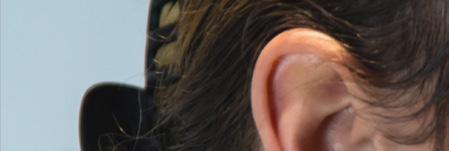


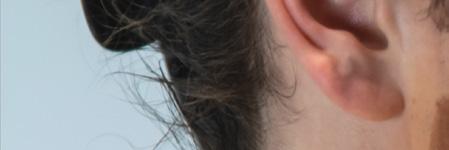




























32 Winter 2023



33 Winter 2023
by Isa Grau &

the




























FUTURE
is NOW
Fashion designers are modern-day alchemists, reimagining the world and synthesizing their beliefs into clothing. Fashion is a space in which designers not only design clothes, but also reimagine society. Issey Miyaki, Iris van Herpen, Marine Serre and Paula Ulargui Escalona are among designers who are writing a new narrative for fashion by using technologically innovative techniques to produce more sustainable garments. Threaded through the clothes are designers' worries and dreams about the world, ones which reflect an increasing global consciousness of the endangered natural world.
Issey Miyaki’s designs take on a life of their own, floating and bouncing down the runway in ways that ordinary dresses seldom do. His collections have shocked and delighted audiences, with dresses drifting from the ceiling onto models or stretching and compressing like accordions around their bodies.
The late Japanese designer pioneered a technologically advanced pleating method to achieve these unique forms. Rather than pleating fabric and then cutting and sewing it, the garments are fully assembled before heat and pressure are applied to create the permanent micro-pleats. The process was the inspiration for Miyaki’s revered line, “Pleats, Please.”
The designs speak to the Issey Miyaki label’s core philosophy: using technological innovation to make a designer item that will last the wearer for life. Miyaki’s readyto-wear pleated garments are machine-washable, durable and wrinkle-proof. They can be worn over and over without losing their form.
They are also emblematic of Miyaki’s career-long fascination with the intersection of industrial design and clothing. In a lecture he delivered after receiving the 2006 Kyoto Prize, Miyaki compared his studio to a research lab where he conducts experiments. Beyond developing pleating technologies, Miyaki constructs garments out of recycled materials and creates forms that defy conventional shapes and silhouettes. His innovations cemented his reputation as far more than a clothing designer — in 1977, he won the Mainichi Design Prize, Japan’s most prestigious award for achievement in design. He was the first non-industrial designer to do it.
Iris van Herpen’s elaborate designs appear far from man-made. The complexity of her designs makes it hard to believe that the Dutch designer does not have a background in science — just a fascination with the natural world that translates into designs resembling the bizarre organisms in biology
textbooks. Her collections often start with conceptual questions, both whimsical and deeply thought-provoking, she told the New Yorker.
Van Herpen and her team contemplate what unusual materials can be turned into fabric, what connects all living organisms, and what challenges are facing our world. Her Fall/Winter 2021 collection titled “Earthrise,” for example, explores the increasingly fragile marine ecosystems being damaged by climate change.
However, the way she produces her designs is anything but natural.
Van Herpen’s designs are made out of recycled and unconventional objects, ranging from Evian bottles to umbrella bones and motorcycle chains.
Maya Krainc
Designers mix advanced technology and fashion to create futuristic worlds on and off the runway.
Designed by Michelle Sheen
ISSEY MIYAKI
34 Winter 2023
IRIS VAN HERPEN
Her fabrics, too, have been made from things like acrylic mesh, iron and foil. She uses technology such as 3D printing and laser cutting to bring it all together. Her garments blur the lines between two worlds: the natural and the hyper-advanced man-made one.
Van Herpen’s designs are more akin to sculptures and artwork than clothing, as she only makes one of each garment and does not produce full collections at the pace most designers do. The beauty of her work is that she takes pieces of the modern world, both the wasteful and the innovative, and creates something breathtaking with them.
passion for design started in her youth, which she spent going to resale shops and sifting through vintage clothing with her grandfather, a secondhand clothing dealer. She is now widely known in the high fashion industry for her passion for upcycling.







Serre stresses the idea of circularity in her business model. She wants pieces from previous seasons to be able to be reused and reinvented. One way she does this is by using recycled denim. Serre uses a laser to print her moon symbol on the denim to make it her own.
Milan, “Siamese Skins: Two Natures, One Body.” The thesis focused on reconnecting humans with nature, aiming to show that the fashion industry has the opportunity to become more sustainable and cyclical, just like nature is.
One of the most recognizable pieces from the collection is a pair of white Loewe sneakers with chia growing on the outside of the shoe, as thought they’d been left out in the wild and been taken over by nature.
Marine Serre’s crescent moon is currently one of high fashion’s most recognizable logos. To the French designer, the moon represents many different things historically. She recognizes the various meanings behind the moon in culture such as life, freedom and fertility. Serre chose the moon for the fluidity of its meaning and recognizability.



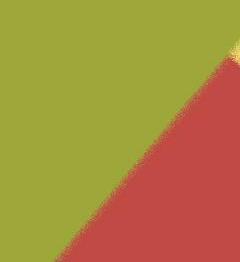




Serre’s signature design is a mesh bodysuit full of crescent moons. Her designs have futuristic elements and her collections can be described as “dystopian.” The top version of the bodysuit is often used for layering to add an interesting element to the skin of the wearer. Serre has stated that she likes to mix sportswear and couture in her designs, giving the brand a very eclectic look.
Serre attended the La Cambre Mode(s) Belgian Fashion Design academy and garnered fame when she won the 2017 LVMH Prize for Young Fashion Designers. But her

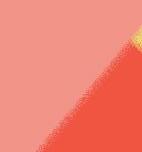
Nearly half of Serre’s collections are made of upcycled products such as carpets, tea towels and cutlery. Her brand is transformative in the movement towards creating high fashion out of used and worn everyday items.
While at the Brockwood Park School in England, Ulargui learned that many students grew their own produce. This led to a love for growing plants and caused her to try and experiment with growing plants from clothing.
Young Spanish designer Paula Ulargui Escalona is a true innovator when it comes to textiles. At the runway for Loewe’s Spring 2023 menswear collection, models walked in clothing adorned with real plants and weeds. These plants, which included cat’s wort and chia, were grown by Ulargui in a polytunnel over the course of three weeks. The collaboration was inspired by Ulargui’s final thesis project at Istituto Europeo di Design in
Ulargui’s research is continuous. Factors like light, fabric and seed type can influence the outcome of her work. A lot of her process is experimental, and the lifespan of the plants is relatively short. She drew a lot of inspiration from a talk she attended on the Anthropocene Era, the current geological era of Earth that expresses how humans have damaged the planet. Ulargui continues to explore how to increase the life span of plants and potentially preserve them forever.
Ulargui combines horticulture and fashion in a way that recognizes the contemporary disconnect between humans and the environment. Her designs give people the opportunity to connect their self expression to the environment while calling into question the role biodegradable materials can play in fashion.
“
”
Her designs give people the opportunity to connect their self expression to the environment while calling into question the role biodegradable materials can play in fashion.
MARINE SERRE
35 Winter 2023
PAULA ULARGUI ESCALONA
By Gigi Cepeda Designed by Iliana Garner
When you hear the word “reinvention,” what comes to mind? A caterpillar, hanging itself up and wrapping itself in silk, waiting to emerge as something more beautiful (or perhaps more palatable to society) as if by a miracle. A lonely teenager donning thick black eyeliner and new clothes like Kat in “Euphoria,” who shows up to high school dressed like a dominatrix. “You look different," Kat's love interest tells her, and she responds: “I changed.” An endless stream of “glow up transformation” videos, prettythin-cisgender-white girls who dye their hair blonder and drink nothing but juice for a few days. They buy trending makeup products and monochromatic Aritzia outfits, appearing on screen at the end of a 15-minute video as something aspirational, something ostensibly better than before.
Transformation, for many of us, is optional. We might hope to reinvent and rebrand ourselves, especially as social media pushes micro-trend cycles, encouraging the grouping of ourselves into aesthetics and enforcing an unattainable standard of beauty. Reinvention is a choice we might make out of curiosity, or even insecurity. If you relate to what’s been written here thus far, you might belong to a privileged group for which reinvention is optional.
And if you aren’t part of this privileged group, reinvention is


much more than a fun activity or a meandering self-exploration. Reinvention can also be a necessity: it can breathe life into one’s physical body and bring truth to the way they are seen.





There still aren’t many complex representations of transness in the media, and the transgender characters we do see often fall into transphobic tropes or, at the very least, tropes which minimize the complexity of the human experience. But in some trans media, we are privy to the type of reinvention that constitutes an art form: the creation of the self.
The most recent and perhaps most popular representation of trans identity is Jules from “Euphoria.” As in most shows with trans characters, her characterization feels incomplete. But as far as representation goes, Jules — and her actress Hunter Schafer,
through pastels, mini skirts, cropped tees and long blonde hair, bringing to mind a type of artistic self-creation that the other characters lack. And where trans characters are typically placed on either side of a harsh line — pre-transition (not cis-passing) or posttransition (cis-passing) — Jules pushes against this binary view of transness. There’s never an explicit discussion of Jules’ gender or transition, she just says she’s “leveling up.” With each level, she gets a little further in her great masterpiece: herself.






who has equally taken the world by storm — is certainly notable.
In the third episode of “Euphoria,” protagonist Rue says, “I’ve never met anyone in my entire life like Jules.” It’s clear to the viewer too that Jules is unique. Jules’ style stands out from the conventional fashion sense of the girls around her. She exhibits hyperfemininity
“So what level are you at now?” her friend Anna asks near the end of Season 1. “I don’t know,” Jules says. “But I definitely haven’t reached my full power.”
She gets closer to her “full power” in the show’s second season. She cuts her hair and wears more androgynous pieces. Lest we think Jules is a fixed manic-pixie-dream-girl, she goes through reinvention
Beyond
Trans stories of reinvention constitute an artistic creation of the self
" "
Reinvention can also be a necessity: it can breathe life into one’s physical body and bring truth to the way they are seen.
the Glow Up
once again. And she doesn’t need to wrap herself up in a cocoon or isolate herself to undergo this transformation; rather, there is a sense that life itself and active participation in it is at the core of her reinvention.





Unlike straight, white and cisgender reinvention, which chases and reinforces an already-established standard of beauty, trans reinvention is the creation of something new — an inside-out transformation rather than outside-in. While popular manifestations of reinvention (the stuff from TikTok) show us how to become something new, trans reinventions show us how to create something new. Becoming is just a replication of what’s already been done before; creating is an artistic process that comes from a reflection of one’s true self.
“creating” comes from none other than Bugs Bunny. In the Netflix documentary “Disclosure,” which explores Hollywood’s impact on trans identity, two trans creatives cite Bugs Bunny as a positive representation of being trans.

If you’re not familiar with Bugs, he spends much of his screen time eluding hunter Elmer Fudd. And one of his best defenses is dressing as a woman. Rather than criticizing or mocking femininity, though, it grants Bugs a unique type of power. Bugs can survive, so long as he is taken for a woman.
“When Bugs Bunny was doing ‘girl,’ Bugs Bunny was desirable and powerful,” historian Susan Stryker says in the documentary. She extols Bugs Bunny as being the only positive representation of trans femininity when she was growing up in the ‘60s.
In Bugs Bunny’s transformation, we can find an example of how breaking gender boundaries can enable survival. In the show, Bugs is only surviving Elmer Fudd. But in real life, survival can mean the emotional and spiritual peace that comes with living as your true self. And in creating a new expression for himself, Bugs also creates a new










power that he wasn't able to access before. (In Bugs’ story, we can also find reflections of real pressures to “pass” as cisgender. What would happen if Elmer Fudd realized it was really Bugs all along? The cartoon is surprisingly illustrative of complex trans experiences.)
So if reinvention enables trans folks to “level up” and find new power, why do so many stories of reinvention fall short — not just in terms of cis reinvention but in media portrayals of trans reinvention, too?





Reinvention is too often seen as catching up to what’s already popular or as an angry abandonment of the self. But reinvention can be much more. Reinvention can be the uprooting of some truth that hides within us, buried beneath layers of constructs and expectations. Reinvention can be the creation of a new truth, one which expresses our individuality beyond what has been modeled before.
In a 2018 tweet that can be found across the internet, author Julian K. Jarboe wrote, “God blessed me by making me transsexual for the same reason he made wheat but not bread and fruit but not wine: because he wants humanity to share in the act of creation. I am only doing the Good Works here on Earth as intended!” Maybe reinvention is much more than how we’ve conceptualized it before — maybe it’s the stuff of gods.
Beyond
37 Winter 2023
An interesting example of this
Transforming yourself can be a freeing process,
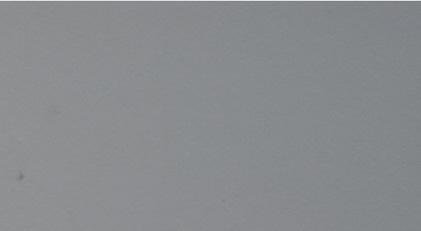




38 Winter 2023


39 Winter 2023


40 Winter 2023
shedding your old skin after hibernation


41 Winter 2023

42 Winter 2023
and coming into a vibrant existence —
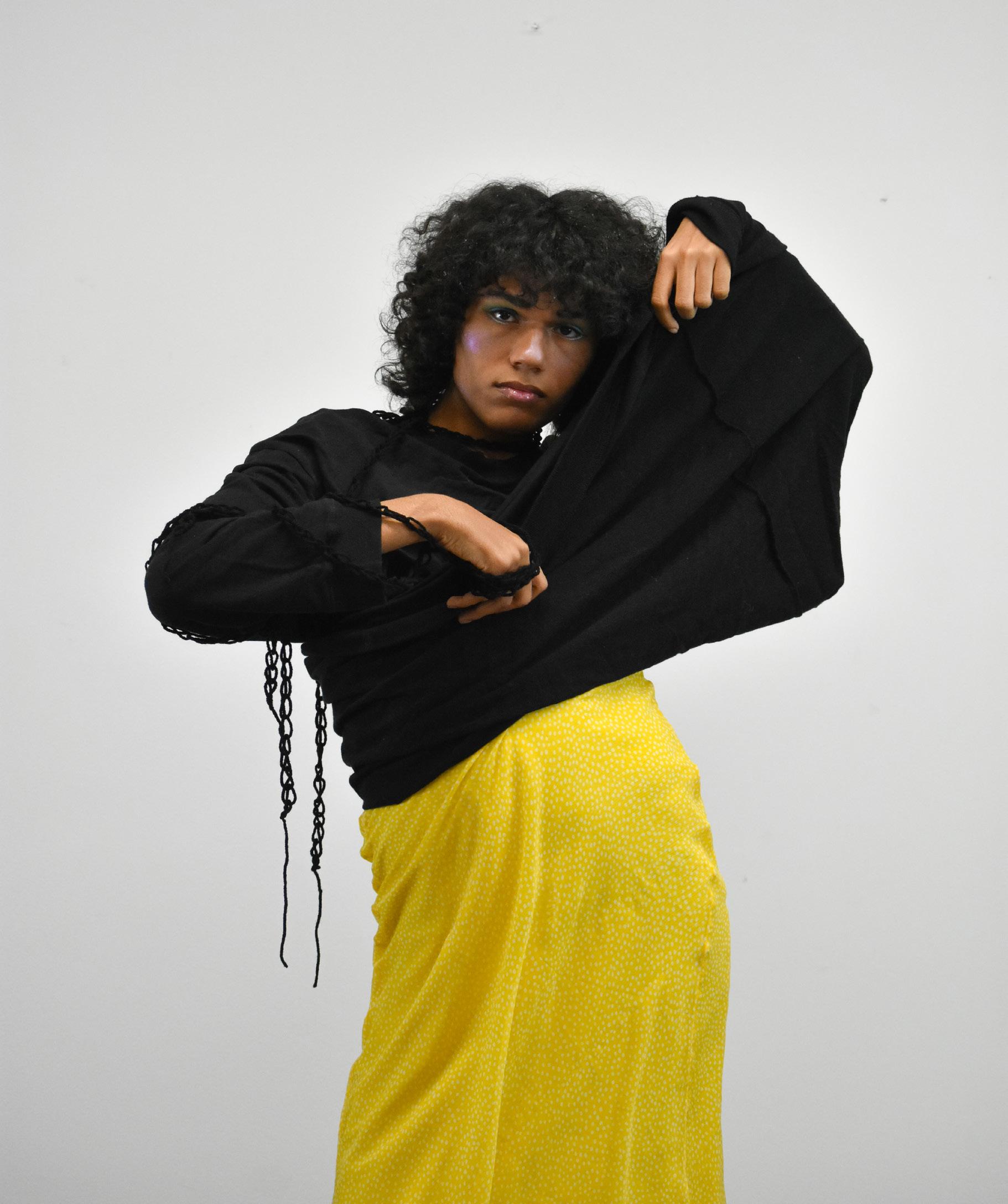
43 Winter 2023


44 Winter 2023


45 Winter 2023
like the reshaping of a caterpillar into a butterfly.

46 Winter 2023
Photoshoot Director: Sara Gronich
Photographer: Hannah Carroll Stylists: Lisa Vicini, Anthony Barba-Perez, Ilise

Angel, Elias Xiwei Fan
Makeup Artists: Sara Gronich, Ilise Angel
Model Relations: Laila Simone Robinson
Designed by: Meher Yeda

47 Winter 2023


















LIPSTICK, AND PANCAKES
by anna souter
designed by wendy zhu

50 Winter 2023
HEELS PANCAKES
a poem

high heels, blazer, angled bob nally wearing lipstick! sweats, dirty hair in a bun seven assignments on canvas. freezing winters, so i pull o my jacket, but the hole in my sleeve reminds me of my mom and i’m supposed to be an adult but i'm stuck with the heart of a child, and i’m supposed to balance in high heels i’ve never worn while impressing the world with my walk.
i tripped. expecting not to, i cried just like when i ipped over the handlebars, training wheels detached, my bottom lip bleeding and swelling and now my lipstick doesn’t look good. oh but it’s the quarter system so you can’t stop.




i’ve tried and i can’t make perfect pancakes. adding the boxed mix to the bowl rst, with a splash of milk, but no! too much milk and now the batter is too liquidy and the determined child-sized heart standing on a foldable green chair to reach the countertop, adds our and they are too clumpy so more milk!
i add more our
i add more milk
i add more of my heart
i add more our
i add more expectation
i add more milk
i add more failures
i add more our
i add more pressure
i add more weight on my pillow
i add more our
i add more alarms to my phone
i add more milk
i add more milk
now i have too much batter and no stove.
wait but im in college
i wear lipstick, i have heels
i can reach the countertop. but i don’t like perfect pancakes, there is a subtle peace in the misshapen circles from where i began.








51 Winter 2023
















 By Marija Jovic
By Marija Jovic




 By Austin Kim
By Austin Kim










 Designed by Wendy Zhu
Designed by Wendy Zhu










































































































































 Image via: Vogue Italia
Image via: Vogue Italia













































































































































































































































